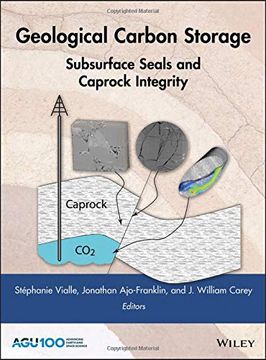Geological Carbon Storage: Subsurface Seals and Caprock Integrity (Geophysical Monograph Series)
Synopsis "Geological Carbon Storage: Subsurface Seals and Caprock Integrity (Geophysical Monograph Series)"
Geological Carbon Storage Subsurface Seals and Caprock Integrity Seals and caprocks are an essential component of subsurface hydrogeological systems, guiding the movement and entrapment of hydrocarbon and other fluids. Geological Carbon Storage: Subsurface Seals and Caprock Integrity offers a survey of the wealth of recent scientific work on caprock integrity with a focus on the geological controls of permanent and safe carbon dioxide storage, and the commercial deployment of geological carbon storage. Volume highlights include: Low-permeability rock characterization from the pore scale to the core scale Flow and transport properties of low-permeability rocks Fundamentals of fracture generation, self-healing, and permeability Coupled geochemical, transport and geomechanical processes in caprock Analysis of caprock behavior from natural analogues Geochemical and geophysical monitoring techniques of caprock failure and integrity Potential environmental impacts of carbon dioxide migration on groundwater resources Carbon dioxide leakage mitigation and remediation techniques Geological Carbon Storage: Subsurface Seals and Caprock Integrity is an invaluable resource for geoscientists from academic and research institutions with interests in energy and environment-related problems, as well as professionals in the field.Book Review: William R. Green, Patrick Taylor, Sven Treitel, and Moritz Fliedner, (2020), "Reviews," The Leading Edge 39: 214-216Geological Carbon Storage: Subsurface Seals and Caprock Integrity, edited by Stéphanie Vialle, Jonathan Ajo-Franklin, and J. William Carey, ISBN 978-1-119-11864-0, 2018, American Geophysical Union and Wiley, 364 p., US$199.95 (print), US$159.99 (eBook). This volume is a part of the AGU/Wiley Geophysical Monograph Series. The editors assembled an international team of earth scientists who present a comprehensive approach to the major problem of placing unwanted and/or hazardous fluids beneath a cap rock seal to be impounded. The compact and informative preface depicts the nature of cap rocks and the problems that may occur over time or with a change in the formation of the cap rock. I have excerpted a quote from the preface that describes the scope of the volume in a concise and thorough matter. "Caprocks can be defined as a rock that prevents the flow of a given fluid at certain temperature, pressure, and chemical conditions. ... A fundamental understanding of these units and of their evolution over time in the context of subsurface carbon storage is still lacking." This volume describes the scope of current research being conducted on a global scale, with 31 of the 83 authors working outside of the United States. The studies vary but can be generalized as monitoring techniques for cap rock integrity and the consequence of the loss of that integrity. The preface ends by calling out important problems that remain to be answered. These include imaging cap rocks in situ, detecting subsurface leaks before they reach the surface, and remotely examining the state of the cap rock to avert any problems. Chapter 3 describes how newer methods are used to classify shale. These advanced techniques reveal previously unknown microscopic properties that complicate classification. This is an example of the more we know, the more we don't know. A sedimentologic study of the formation of shale (by far the major sedimentary rock and an important rock type) is described in Chapter 4. The authors use diagrammatic examples to illustrate how cap rocks may fail through imperfect seal between the drill and wall rock, capillary action, or a structural defect (fault). Also, the shale pore structures vary in size, and this affects the reservoir. There are descriptions of the pore structure in the Eagle Ford and Marcellus shales and several others. Pore structures are analyzed using state-of-the-art ultra-small-angle X-ray or neutron scattering. They determine that the overall porosity decreases nonlinearly with time. There are examples of cap rock performance under an array of diagnostic laboratory analyses and geologic field examples (e.g., Marcellus Formation). The importance of the sequestration of CO2 and other contaminants highlights the significance of this volume. The previous and following chapters illuminate the life history of the lithologic reservoir seal. I would like to call out Chapter 14 in which the authors illustrate the various mechanisms by which a seal can fail and Chapter 15 in which the authors address the general problems of the effect of CO2 sequestration on the environment. They establish a field test, consisting of a trailer and large tank of fluids with numerous monitoring instruments to replicate the effect of a controlled release of CO2-saturated water into a shallow aquifer. This chapter's extensive list of references will be of interest to petroleum engineers, rock mechanics, and environmentalists. The authors of this volume present a broad view of the underground storage of CO2. Nuclear waste and hydrocarbons are also considered for underground storage. There are laboratory, field, and in situ studies covering nearly all aspects of this problem. I cannot remember a study in which so many different earth science resources were applied to a single problem. The span of subjects varies from traditional geochemical analysis with the standard and latest methods in infrared and X-ray techniques, chemical and petroleum engineering, sedimentary mineralogy, hydrology, and geomechanical studies. This volume is essential to anyone working in this field as it brings several disciplines together to produce a comprehensive study of carbon sequestration. While the volume is well illustrated, ther

